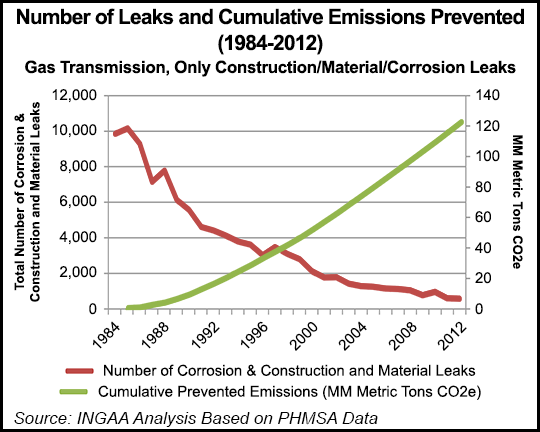Infrastructure | NGI All News Access | NGI The Weekly Gas Market Report
NatGas Transmission Pipe Leaks Reduced, But More Can Be Done, INGAA Says
Citing the U.S. natural gas transmission industry’s work over the last 30 years in greatly reducing the number of pipeline leaks as a result of pipeline safety efforts, maintenance programs and modernization and expansion projects to ensure system reliability and resiliency, the Interstate Natural Gas Association of America’s (INGAA) board of directors vowed Tuesday to build on the industry’s success by developing guidelines that enhance efforts to discover and repair leaks from pipelines and associated equipment.

INGAA CEO Don Santa said the association’s efforts to establish guidelines to reduce emissions from pipeline equipment will put “a particular focus” on the types of equipment with the largest emissions profile.
“The natural gas transmission pipeline industry reduced the number of leaks by 94%, preventing 122 million metric tons of CO2-equivalent emissions over the past three decades, as a result of pipeline integrity and maintenance programs and continued investment in new pipeline facilities,” Santa said. “These prevented emissions are equivalent to removing more than 25 million passenger vehicles from the road for one year.”
INGAA’s remarks came as the White House and the U.S. Department of Energy (DOE) on Tuesday hosted the fifth in a series of meetings on reducing methane emissions from natural gas systems. Following the meeting, Secretary of Energy Ernest Moniz announced several initiatives as DOE’s part of the administration’s Strategy to Reduce Methane Emissions.
“By expanding our discussions through these methane roundtables, we have heard from several different groups about the benefits to finding workable solutions to the problem of methane leakage,” said Moniz. “These benefits include job creation through pipeline and other equipment replacement, cost recovery for infrastructure investments that increase safety and save energy, and opportunities for addressing climate change by reducing greenhouse gas emissions.”
To address methane leakage from natural gas systems, DOE announced steps to help modernize the nation’s natural gas transmission and distribution systems. As part of the overall Administration’s methane strategy, the Energy Department’s Initiative to Help Modernize Natural Gas Transmission and Distribution Infrastructure includes:
The roundtables brought together representatives from industry, labor, academia, environmental and non-governmental organizations, and manufacturing, as well as states and localities to identify opportunities, technical solutions, and best practices to reduce methane emissions from a range of sources.
INGAA said widespread pipeline replacement is not the answer for improving pipeline safety or reducing methane emissions from the natural gas transmission sector, which is different from the natural gas distribution sector, where some systems still include obsolete cast iron pipe.
INGAA added that “virtually all of the material” used by the natural gas transmission sector is pipeline-quality high-grade steel, and that pipe replacement in the natural gas transmission sector requires — for safety and operational reasons — the venting of large quantities of natural gas into the atmosphere.
“Pipes that are unsafe must be repaired or replaced, no matter what the emissions implications,” INGAA said. “Still, policymakers should be aware that pipe repair and replacement activities on transmission systems cause significant venting emissions. They should weigh the consequences of such emissions against mandating future activities that do not add demonstrably to safety.”
INGAA said it will develop industry guidelines for directed inspection and maintenance (DI&M) of natural gas pipeline facilities. DI&M is a EPA-recognized tool for detecting and mitigating leaks in a cost-effective manner. The association allowed that while most INGAA member pipeline companies use DI&M, the guidelines will improve consistency and uniformity, which should result in further emissions reductions. INGAA will work with research groups to create a roadmap for developing technological innovations to make DI&M even more effective. In addition, the association, along with several member companies, is working with Colorado State University and Carnegie Mellon University in collaboration with the Environmental Defense Fund to help further validate and refine the estimates of GHG emissions from transmission and storage facilities.
Growing U.S. gas demand will also require more transportation infrastructure to be built in the coming years. According to an INGAA Foundation research report released in March (see Daily GPI, March 6), the United States and Canada will require each year through 2035 an average of 850 miles of new natural gas transmission mainlines, 800 miles of new laterals to and from power plants, processing facilities and storage fields and almost 14,000 miles of new gas gathering lines to bring new gas supplies to growing markets.
INGAA believes this estimated $30 billion per year investment in midstream pipeline infrastructure will benefit the environment by reducing upstream and downstream greenhouse gas emissions, because less gas will be flared and more gas will be used to displace higher emitting fuels. The association said that improvements to the pipeline permitting process would help the nation to realize more rapidly and more fully the benefits of its natural gas abundance, and that it looks forward to working with the Obama administration to find other partnership opportunities, including research and development, to encourage even greater emissions reductions from natural gas transmission pipelines.
© 2024 Natural Gas Intelligence. All rights reserved.
ISSN © 1532-1231 | ISSN © 2577-9877 | ISSN © 1532-1266 |
